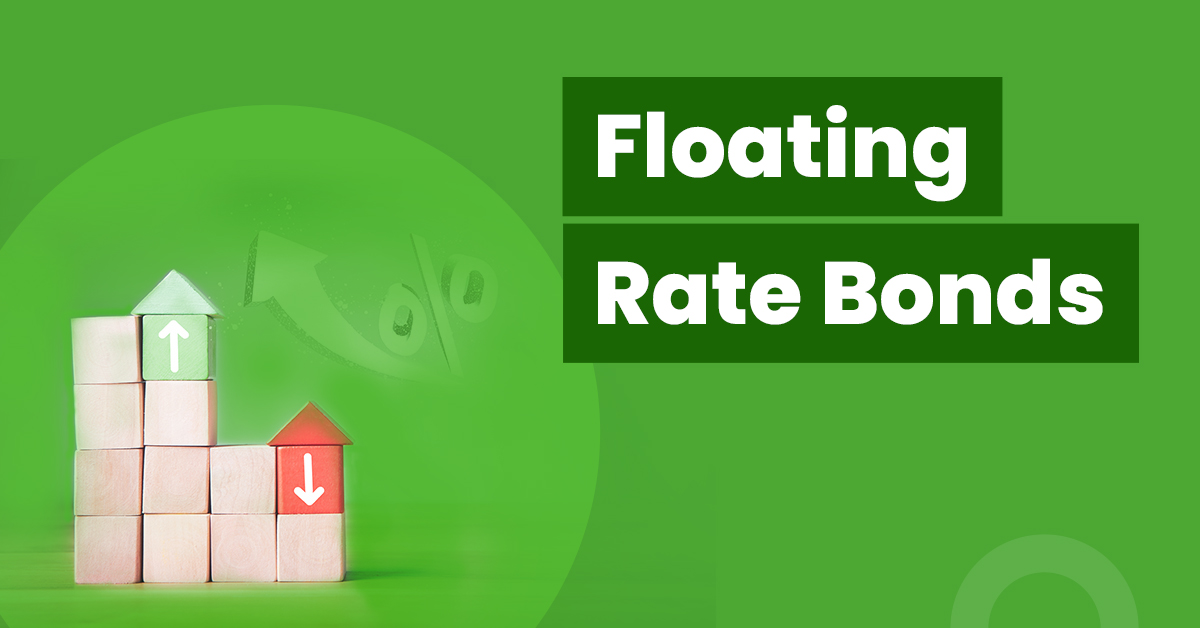What are Floating Rate Bonds in India? Example, Int. Rates, Advantages & Disadvantages


Governments and private companies are frequently in need of capital for ambitious projects. Whether it’s the government aiming to construct vital infrastructure for the nation or businesses venturing into new products or markets, often their earnings alone can’t shoulder the cost. Traditional borrowing methods, such as taking loans from banks, can entail numerous constraints. In such cases, they turn to the public to amass debt, leveraging instruments like bonds and debentures.
Among these, bonds, especially floating rate bonds where the interest or coupon rates can vary based on a benchmark, play a pivotal role. Bonds can be primarily classified into fixed and floating-rate bonds based on the stability of their interest rates over the bond’s tenure.
What is a floating rate bond?
A bond is a debt instrument issued by a company or government to raise funds. When you buy a bond, you agree to receive periodic interest payments and a principal amount called the “face value” at its maturity. The interest rate of a bond can be fixed or floating.
Bonds typically have a predetermined coupon or interest rate. For instance, you may purchase a bond for Rs. 20,000 with a 5% coupon rate. In the case of such a bond, the bond issuer will pay you Rs. 1,000 as interest each year. This interest is fixed and does not change basis the market’s current interest rate.
However, in the case of a floating rate bond, the interest rate is a variable. The interest rate of a floating rate bond is linked to a benchmark rate decided at the time of bond issuance. This interest rate is revised quarterly, half-yearly or annually as announced at the time of bond issue.
How do floating rate bonds work?
As discussed above, a floating bond pays a variable interest rate that is linked to a benchmark interest rate. The benchmarks that are most commonly used in India are repo and reverse repo rates.
For fixed coupon (interest) rate bonds, when the market interest rates increase, the bond prices fall to match the yield of the current bonds. In the case of floating rate bonds, the coupon rates move up or down with the market interest rates without much impact on the bond price. It is especially beneficial to buy floating rate bonds when you expect the market interest rates to go up.
Due to their peculiar nature, there are both advantages and disadvantages to investing in floating rate bonds.
Types of Floating Rate Bonds
As we know, floating-rate bonds have dynamic interest rates based on market changes. However, when it comes to primarily concerning India, Floating rate bonds are of two principal types:
Callable Floating Rate Bonds: A callable floating rate bond grants the issuer the privilege to redeem the bond prior to its maturity, returning the principal amount to the bondholder in full.
Non-Callable Floating Rate Bonds: Non-callable floating rate bonds don’t offer this early redemption option to the issuer. For such bonds, the issuer is obligated to pay the interest, pegged to a specific benchmark, even if it results in financial setbacks for them.
Advantages of Investing in a Floating Rate Bond
Market prices are subject to lower volatility
The prices of floating-rate bonds are relatively less volatile as compared to fixed-rate bonds. This is because, in fixed-rate bonds, the bond prices have to adjust as per market interest rates and yield; in the case of floating-rate bonds, the interest rates get adjusted due to their pegging with a market benchmark. The bond prices, therefore, remain less affected by any market changes.
High returns
The returns from floating rate bonds come from coupon payments and any discount/premium to the face value at which you might have purchased them. In an increasing interest rate environment, the returns are usually higher than other fixed return instruments. Also, due to a spread above the benchmark rate, the returns from floating rates turn out to be high.
Safety
Floating rate bonds are usually issued by government bodies. Therefore, the likelihood of default is negligible.
Diversification
From a macroeconomic perspective, an inverse relationship is seen between stock market performance and interest rates. Floating rate bonds can balance the risk profile of your portfolio. Those looking to diversify their investments can invest in these bonds to earn decent returns with low risk.
Disadvantages to Investing in Floating Rate Bonds
Lower yield
The interest rates of floating rate bonds move with the market-linked benchmark. As a result, a fall in interest rates could lower the yield of the bond in comparison to a fixed interest rate bond.
Interest rate risk
There could be a lag between market interest rate changes and the benchmark rate. This, in turn, would mean that the coupon payment on floating rate bonds continues to receive lower interest than the market rates.
Credit risk
When the government is the issuer, this risk is greatly mitigated. Bonds, being a debt instrument, always carry a risk of a payment default. As a bondholder, you should continuously monitor the creditworthiness of the issuers of the bonds you hold.
Example of a Floating Rate Bond
Let’s look at an example of a floating rate bond recently issued by the RBI. The bond was announced in June 2020 and was available for investment from July 1st, 2020. The bond’s coupon rate was pegged to the interest rate of the National Savings Certificate (variable component) with a spread of 35 basis points (fixed component) higher than it.
RBI announces rate of interest on Government of India Floating Rate Bonds, 2024
Interest Rate on RBI Floating Rate Bond 2023
The benchmark above is the interest rate on the National Savings Certificate. The coupon rate on the bond is reset every six months to match the movements in the NSC. For example, the current NSC interest rate is 6.8%. Therefore, the coupon rate is 6.8 + 0.35 = 7.15%.
How to Buy a Floating Rate Bond
For Government issued bonds: You can buy RBI-issued bonds online through RBI Retail Direct or NSEGoBid platforms. You must have a Demat account to invest in bonds. You will have to register on these platforms and submit your KYC documents. Then, you can buy/sell floating bonds by making payments via the bank account linked to your Demat account.
There is also an option to buy these bonds offline by submitting an application to SBI or other nationalised banks authorised by the RBI to sell these bonds.
Corporate Bonds: You can buy/sell corporate bonds through your broker account linked to your Demat. The bonds have scrip codes and can be bought just like stocks. There is also an option to directly buy some bonds from the exchanges’ websites.
Before buying bonds, the most important thing to check is the creditworthiness of the issuer. The creditworthiness is determined by the ratings provided by SEBI-registered credit rating agencies such as CRISIL, ICRA and CARE.
Key Takeaways
A floating rate bond is a debt instrument with no fixed interest rate; a predefined formula periodically determines it. These bonds are also known as floaters or adjustable rate bonds.
Government, corporations or financial institutions issue floating rate bonds with 2 to 5 years of maturity & the interest is paid bi-annually in July and January.
What is the Role of Floating-Rate Bonds in a Portfolio
Diversification is a good sign of a healthy portfolio primed for high returns with optimal risk. That being said, here are a couple of reasons why floating-rate bonds help in building a strong portfolio:
Acts as an Effective Hedge: Hedging against potential losses is one of the primary functions of a good portfolio. Floating-rate bonds change their interest payouts based on current market rates. So, when market rates go up, these bonds can pay more. This flexibility means they’re less shaky with rate changes and can be a good guard against the risks of rising rates.
Diversification: Floating-rate bonds can add variety to a portfolio. Mixing them with other investments like fixed-rate bonds and stocks can help balance things out, making the portfolio less prone to big changes.
Potential Income: With the increase in interest rates on these bonds, the potential increase in income also increases, making these bonds a good addition to your portfolio.
Duration Risk: Duration shows how bond prices react to interest rate changes. Floating-rate bonds usually react less to these changes than fixed-rate bonds, making their prices more stable.
FAQs
What is the difference between fixed rate bonds and floating rate bonds?
The interest rate on fixed rate bonds is fixed, that is, it remains constant throughout the entire tenure of the bond. On the other hand, the interest rate on floating rate bonds is pegged to a benchmark rate (there is a fixed and a variable component). It changes as the benchmark rate changes. For example, the interest rate for RBI floating rate savings bonds is linked to the interest rate on the National Savings Certificate (NSC).
What are the minimum and maximum amounts of investment in the RBI floating rate savings bonds?
You can invest a minimum of Rs. 1,000 in the floating rate bond issued by the RBI. There is no upper limit on the amount invested in the bonds.
What is the tenure of the RBI floating rate savings bonds?
The tenure of the RBI floating rate savings bond is seven years.
Are floating rate bonds a good investment?
Floating rate bonds are a good investment, especially when interest rates are expected to increase. While no one can predict the total return of a floating rate bond, they usually have high returns compared to many other instruments.
What is the best time to invest in floating rate bonds?
Since the interest rate on floating rate bonds is pegged to a benchmark rate, it is better to invest in floating rate bonds when the market interest rates are expected to increase.
Do floating rate bonds have interest rate risk?
Yes, floating-rate bonds have interest rate risk, but it’s generally lower than fixed-rate bonds.
How often do the floating rates adjust?
Floating rates typically adjust at regular intervals, often every 3, 6, or 12 months.
Who should consider investing in Floating-rate bonds?
Investors seeking protection against rising interest rates and diversification should consider floating-rate bonds.
What is the floating rate bond formula?
The floating rate bond formula links the bond’s coupon rate to a benchmark rate plus a spread.
What is the minimum and maximum investment limit in the Floating Rate Savings Bonds?
For Floating Rate Savings Bonds in India, the minimum investment is ₹1,000, and there’s no maximum limit.







